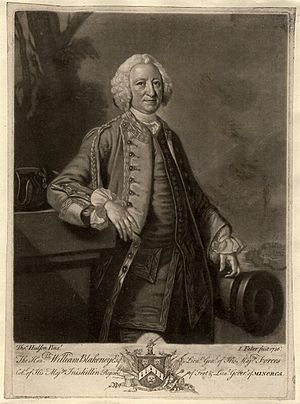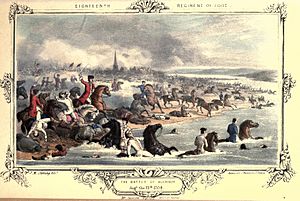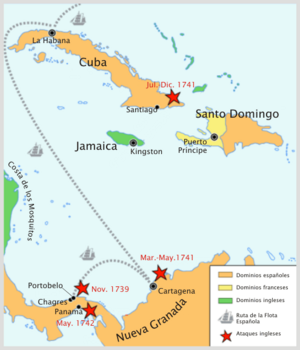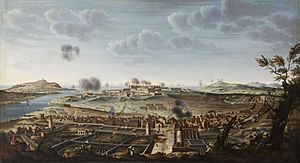William Blakeney, 1st Baron Blakeney facts for kids
Quick facts for kids
The Lord Blakeney
|
|
|---|---|
 |
|
| Lieutenant Governor of Menorca | |
| In office 1748–1757 |
|
| Governor of Stirling Castle | |
| In office 1742–1748 |
|
| Member of Parliament for Kilmallock, Irish Parliament |
|
| In office 1725–1757 |
|
| Personal details | |
| Born | 7 September 1672 Mount Blakeney, County Limerick |
| Died | 20 September 1761 (aged 89) Mount Blakeney, County Limerick |
| Resting place | Westminster Abbey |
| Nationality | Irish |
| Relations | Robert Blakeney (1679-1733); |
| Parents | William (1640–1718); Elizabeth (1652–1710) |
| Occupation | Soldier and landowner |
| Military service | |
| Allegiance | Great Britain |
| Years of service | 1695-1756 |
| Rank | Lieutenant General |
| Unit | Colonel, 27th Foot, later Inniskilling Regiment |
| Battles/wars | |
Lieutenant-General William Blakeney, 1st Baron Blakeney (7 September 1672 – 20 September 1761) was a brave and skilled British Army officer and politician. He served in the army from 1695 until 1756. He was also a member of the Parliament of Ireland for Kilmallock from 1725 to 1757, though he was often away on military duty.
Blakeney was known for being a tough and reliable soldier. He also had new ideas for how soldiers should train and use their weapons. He became very famous during the Jacobite rising of 1745, a conflict in Britain. After this, he was made Lieutenant-Governor of the British island of Menorca in 1748.
In April 1756, the Seven Years' War began, and French forces took over most of Menorca. However, Blakeney and his soldiers at Fort St. Philip bravely defended the fort for 70 days. Even though Admiral John Byng was later punished for not helping Blakeney, Blakeney himself was made a baron for his strong defense.
After this, Blakeney, who was over 80 years old, retired from the army. He went back to his home in County Limerick, Ireland. He passed away in September 1761 and was buried in Westminster Abbey. He never married, so his title ended when he died.
Contents
William Blakeney's Early Life
William Blakeney was born on 7 September 1672. He was the oldest child of William Blakeney (1640–1718) and Elizabeth Blakeney (1652–1710). He had several brothers and sisters, including Robert, Charles, John, Mary, Catherine, and Elizabeth.
The Blakeney family owned land in Castleblakeney, County Galway, and Mount Blakeney, in County Limerick. For over a hundred years, members of his family were important figures, serving as Members of Parliament and High Sheriffs. William Blakeney inherited his father's property. He never married, so when he died in 1761, his property went to his younger brother, Major Robert Blakeney.
Blakeney's Military Journey
Starting His Army Career (1695-1739)
During the Williamite War in Ireland (1689 to 1691), William Blakeney stayed at Mount Blakeney to protect his family's land from attacks. In 1692, he joined his uncle George Blakeney in Flanders. He was a volunteer soldier and was injured during the Siege of Namur in 1695. This event is said to have inspired the famous song 'The British Grenadiers'.
In September 1695, he officially became an ensign in The Royal Regiment of Foot. After the 1697 Treaty of Ryswick, which ended a war, he was put on half-pay, meaning he received less money because he wasn't actively serving.

When the War of the Spanish Succession started in 1701, Blakeney returned to active duty. He fought in major battles like Schellenberg, Blenheim, and Ramillies. He was promoted to captain in April 1707. In March 1708, he became a lieutenant in the Foot Guards.
Guards officers often held a second, higher army rank. For example, a Guards lieutenant might be ranked as an army major. This system helped reward good officers. Blakeney's regiment was not disbanded after the 1713 Peace of Utrecht. In 1718, his uncle retired and gave his lieutenant colonel position in the 31st Foot to Blakeney. He held this rank for 20 years. In 1737, he became a colonel of the 27th Foot.
Battles and Sieges (1740-1748)

In 1739, a conflict called the War of Jenkins' Ear began due to trade disagreements with Spain. Blakeney was made a brigadier general and sent to join Admiral Vernon's forces. He was chosen because of his excellent training skills. His force included 3,000 new American colonial soldiers.
He took part in the difficult attack on Cartagena de Indias in March 1741 and the brief occupation of Cuba. The Caribbean was a very unhealthy place for soldiers. Many died from disease, and simply surviving was a great achievement.
After these campaigns, the surviving soldiers returned to Britain in October 1742. Blakeney was then appointed lieutenant governor of Stirling Castle. This castle was a very strong fortress that controlled the path between the Scottish Highlands and the Lowlands.
In September 1745, the Jacobite army marched past Stirling Castle on their way to Edinburgh. However, they did not have the right equipment to capture it. The Jacobites made a more serious attempt to take the castle in January 1746 during the Siege of Stirling Castle. Even though they won the Battle of Falkirk Muir on 1 February, the Jacobites stopped their siege and moved to Inverness. This happened when Prince William, Duke of Cumberland started moving north from Edinburgh. After the Jacobite Rising ended at Culloden in April 1746, Blakeney was promoted to lieutenant general. He was also given military command of the Highlands.
Defending Menorca (1748-1761)

In 1748, Blakeney became lieutenant governor of Menorca. This island was very important for Britain to control the Western Mediterranean Sea. However, it was also easy to attack. Spain did not like British control, and the island was close to French naval bases.
The main governor, Baron Tyrawley, never visited Menorca. This meant Blakeney was the real ruler of the island. He tried to make the local people happier by encouraging his soldiers to marry local women and by overseeing Catholic schools. However, these efforts were not very successful. The defenses of Menorca were also in poor condition, with crumbling walls and old gun platforms. Many senior officers were also absent from their posts.
When the Seven Years' War began in April 1756, the French quickly took over the island. They then began the Siege of Fort St Philip, which Blakeney commanded. An attempt by Admiral John Byng to help the fort was stopped in May. Blakeney surrendered the fort on 29 June. The soldiers were allowed to leave safely for Gibraltar.
After the siege, there was an investigation. Admiral Byng was later executed in March 1757 for failing to help Blakeney. Blakeney was rewarded for his brave defense. He was given the Order of the Bath and made 'Baron Blakeney' in the Irish peerage. This marked the end of his military career. He died on 20 September 1761 in Ireland and was buried in Westminster Abbey. His gravestone is still there, but the writing is now very faded.
Blakeney's Lasting Impact
Blakeney was very interested in how soldiers trained and used their weapons. He even suggested using puppets to show new recruits how to perform drill positions. After the Battle of Culloden, he was asked to show his own ideas for military drills. However, a new standard training manual was released in 1748, and his suggestions were not used.
In 1759, a statue of Blakeney was put up in Dublin. It was paid for by a group called the Friendly Brothers of Saint Patrick. The statue was located where the Spire of Dublin stands today. However, the statue was badly damaged and removed in 1763.

